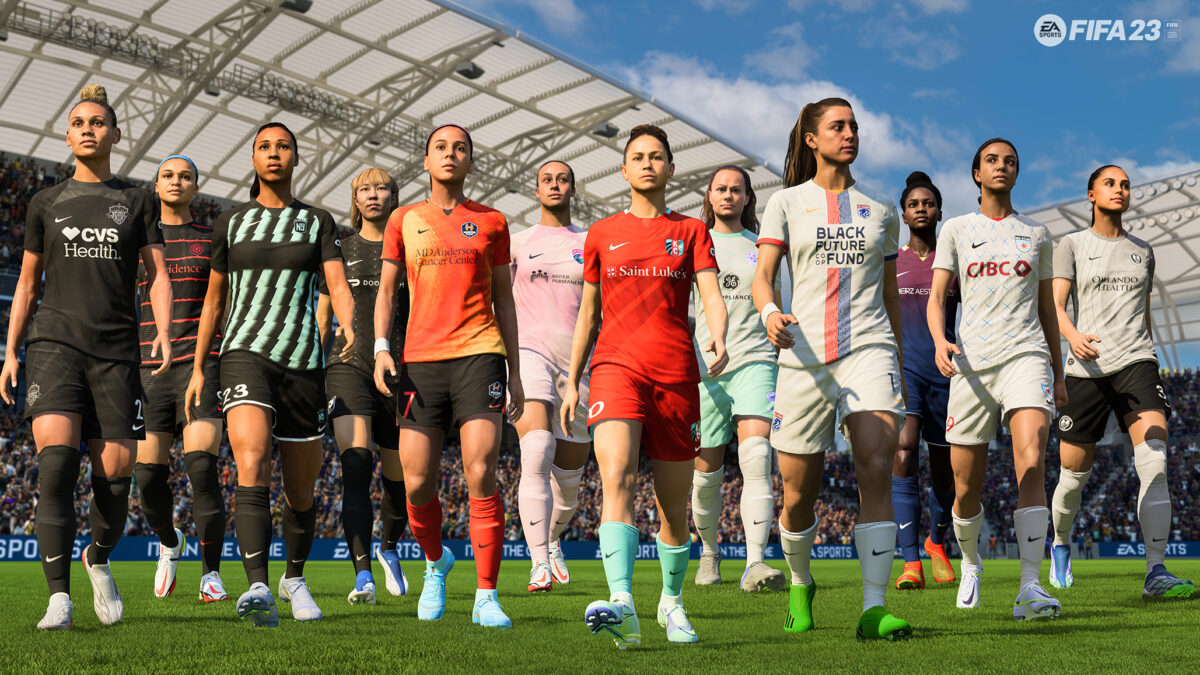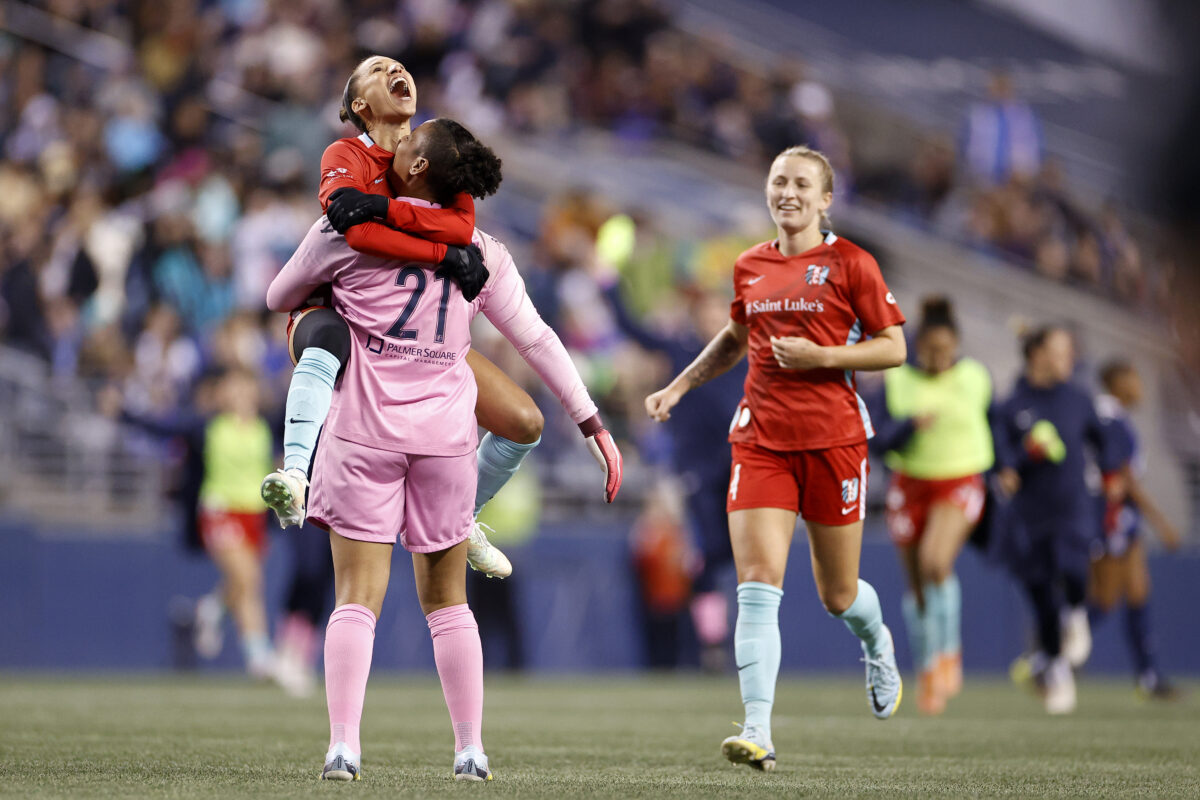The NWSL championship game ended up being a fairly decisive 2-0 win for the Portland Thorns. A tumultuous season off the field didn’t manifest at all in the final, where they pounced on an early mistake to get a lead over the Kansas City Current, and never looked back.
It was an impressive, imperious kind of performance, and one built around a perfect blend of individuals stepping up, good management, and calm leadership. The clash of styles went decisively in their favor from minute one, leading to celebrations at Audi Field heading towards the Rose City Riveters on the north side of the stadium rather than to the Blue Crew behind the opposite goal.
Here are four major factors that explain how the Thorns earned their third star:
Experience pays off
There were aspects of Saturday’s final that recall the 2019 NWSL championship, in which the North Carolina Courage jumped all over the Chicago Red Stars and effectively put the game to bed in the first half-hour.
To be clear, Kansas City certainly had a better day in DC than Chicago did in Cary. For one thing, it has to be said that the Red Stars were very much not a model club at the time, while Current players are glad to tell anyone that asks how the investment in them has brought them to a better place mentally. When the going gets tough — and it did in the first half of this game — Kansas City has a mental toughness that hasn’t been depleted by their own coach or ownership. It matters on the field.
Still, there were some broad similarities that gave a hefty edge to the traditional power in this game. The Thorns have a roster full of players with championships, and a larger staff of people who have operated through the strange barrage of requests and activities that come with a championship weekend. Kansas City, an organization with barely two years of existence in their current form, can hardly be blamed for being a little behind Portland on this front. They’re doing amazing things, but some gaps can only be filled out with time.
This also hits on the field, where the Thorns have a squad full of players who were indisputably leaders for title-winning teams in the past: Becky Sauerbrunn, Christine Sinclair, and Meghan Klingenberg all started, and Crystal Dunn came in off the bench. Emily Menges and Tegan McGrady were on the bench as well. That’s a group that has collectively been in the starting lineup for eight NWSL championship wins.
Kansas City’s players had alluded to the value of the experience AD Franch and Kristen Hamilton brought when they came in via trades last year, but when it comes to appearing in and winning an NWSL final, they were the list for the Current. Desiree Scott mentioned more than once that despite having seemingly been through everything one can go through in women’s soccer, she’d never played in an NWSL final before. There’s experience, and experience in this particular maelstrom.
All of which is a long build-up to the most decisive factor in this game: the Current showed some nerves. Their defenders seemed to be less instinctive and certain than normal, and the entire group’s first touch was not up to the regular standards they’ve set over the year. Portland’s structured, counter-pressing approach took advantage of the apprehension in the ranks time and again.
Thinking long-term, Kansas City will benefit immensely from going through this experience, and it would be foolish to bet that this group — after such a rapid turnaround this year — caught lightning in a bottle. They’ll be back, and be better when they make their return.
On Saturday, however, the difference in experience showed.
Unsung heroes
Smith’s powerhouse performance, summed up with the perfect celebration for the moment, got deserved plaudits, as did Franch for making numerous saves to keep KC in the match.
However, it would be remiss to not mention that Sauerbrunn’s vaunted organizational ability was on full display. The Current’s nebulous, improvisational shape going forward can be a nightmare to sort out, especially given the speed found throughout their team. And yet, Portland always seemed to know exactly what was being cooked up, and Sauerbrunn was at the heart of those solutions for 90 minutes.
Natalia Kuikka also has to be recognized for a quietly superb performance at right back. The Finnish international had a bit of a mid-season lull this year, but rounded into form and stood out against a KC attack that skewed pretty heavily towards attacking her side. The Current really tried to find a way through, attempting 10 dribbles out towards the touchline in Portland’s half, and only one from Kizer worked out positively.

Those red triangles are all where Kansas City dribbles didn’t pan out. There were also no key passes (those are the yellow squares above) from Kuikka’s flank, and only two successful crosses, one of which came deep enough that it’s more of a midfielder’s job anyway.
Sauerbrunn looked at ease, but only because she was putting on a masterful show in terms of thinking the game and denying Kansas City by superior positioning. Kuikka, meanwhile, had a ton of more tangible work to do, winning tackles and individual battles. If you want to know how Bella Bixby ended up without having to make a single save on a night where the game state and attack-minded opposition should have meant a lot of work, look no further than these two (very different) performances.
Adjustment analysis, part one
Both coaches made interesting moves, with Portland making their big change before kickoff and Kansas City opting for a major shift as the game was going on.
For the Thorns, Rhian Wilkinson elected to make an enormously difficult choice, keeping Hina Sugita — a sleeper Best XI candidate after a thoroughly impressive first year in the league — on the bench in favor of Sinclair.
Asked post-game from a crowded Audi Field media room about that change, Wilkinson said it was “a huge decision, and it was a really hard decision,” before adding that for the challenge of Kansas City, she wanted a more clear structure. “I played a really distinct six, eight and 10 in the midfield, and Hina for me, she’s an eight or a winger,” explained Wilkinson. “I think Rocky (Rodríguez)’s been flying the last few games, so she just sort of started ahead of her.”
The Thorns had deployed a 4-3-3 for their semifinal against the San Diego Wave, with Sugita and Rodríguez both operating as attack-minded No. 8s having the freedom to go forward. Wilkinson said that against the Wave, she wanted her team to focus on playing through lines more, whereas she shifted her side into more of a 4-4-2, with Sinclair being available for passes to feet rather than in behind.
“I wanted to play with the front two, and Sincy’s one of the best in the world at reading that front-two position and being alongside Sophie and feeding her,” said Wilkinson. “It wasn’t a breaking the lines type of game like in San Diego, where we played two eights-tens.”
It’s the kind of gambit that could have blown up in Wilkinson’s face, but in the end, the team she put on the field created a Portland Thorns kind of game. That’s no mean feat against a Kansas City team that has thrived at forcing just about everyone into a style that favors the Current.
Adjustment analysis, part two
Matt Potter had no surprises in his starting lineup, with the exact same 11 that started the semifinal being picked for the final. He did make a shift, though, pushing Lo’eau LaBonta higher and playing with Scott and Alex Loera as a double-pivot as opposed to Scott being the lone holding presence.
That change didn’t really come off, though Potter said post-game he saw moments where their play through the middle went as planned until it came time to play the final ball.
Where things were really going awry was along the back line. Sophia Smith told Pro Soccer Wire on Thursday that she felt like she’d find more space against a back three, and it turns out the forward knows what she’s talking about. Kansas City was struggling to protect its defenders from being isolated, with support arriving late or not at all, and for the first 30 minutes, they had to make plenty of emergency blocks at full stretch just to keep the score at 1-0.
Potter’s answer ended up being to convert Kate Del Fava from a right wingback to a true right back, staying home to support Addisyn Merrick and shifting Kansas City into a back four. Further forward, the domino effect saw LaBonta and Hamilton have to trade shifts providing width on the right, while most of the Current’s attacking thrust ended up centered on Hailie Mace on the left.
Potter wasn’t thinking purely about stopping the bleeding, though, and said he made the change in part to take advantage of the spaces Portland’s more rigid structure left open.
“Well, I think they were attacking well in wide areas, but when they create the structure that they do, it creates pockets of space in the midfield that we wanted to try and take advantage of,” Potter told reporters after the match. “By keeping Kate home a little bit for a period of time, the hope was to get Kristin Hamilton and Cece (Kizer) on the ball in central areas a little bit more.”
“You’ve got to give up things to get things and there’s a risk/reward factor in the game,” added Potter. “The identity of this team’s lived all year is to have no fear, and to try and take the game to the opponent. Why would we change that because we’re here? We are what we are, they deserved that opportunity to go express themselves again, and you know with a little bit of a ball bouncing one way or another, then maybe we are talking about a different game.”
As much as Portland managed this game in incredibly efficient fashion, Potter’s not off-base by saying that the Current just needed a bounce. Specifically, the bounce that cost them the second goal is one that could have easily played out with the ball nestling into Franch’s gloves, or not skipping so hard off the grass that Addisyn Merrick could have cleared it away before it got over the line. While the first half was triage for Kansas City, the second half saw them gain some footing, only for that goal to put things out of reach.
[lawrence-related id=9004,8987,8912]
Introducing new #FIFARatings for the @NWSL






